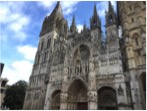
Cal Hockemeyer ’19—Having the opportunity to spend a semester 4,000 miles from home while pursuing my education was perhaps the most intellectually enlightening time of my life. Having to adapt to another culture while learning and taking classes in a second language was an incredibly enriching experience that will affect me for years to come in more ways than I can possibly predict. One area in which I really grew during those four months was in my understanding and appreciation of the visual arts. Due to the unwavering generosity of the Givens family, I was able to supplement my classroom education by traveling to Paris, Rouen, Giverny, and Amsterdam to see some of the world’s finest paintings.
The art movement that I was primarily concerned with studying was that of the impressionists, so it was only natural that I visited Paris. The first museum I visited there was the Musée d’Orsay, home of the most highly renowned collection of impressionist paintings in the world. This collection contains paintings from the most important of the French Impressionists, including Manet, Pissarro, Degas, and Monet. Some of my favorite paintings in this collection include Monet’s La gare Saint-Lazare and La rue Montorgueil.
While in Paris, I also had the opportunity to see the Musée Marmottan Monet as well as the Musée de l’Orangerie. The former has a large collection of works from the different parts of Monet’s life while the latter houses Monet’s eight Water Lilies murals. The Musée Marmottan Monet also contains paintings that Monet collected throughout his lifetime, both from close friends such as Pierre-Auguste Renoir as well as the Japanese prints which had a great influence on Monet’s craft. Here, I was able to see not only how Monet’s subjects and style changed over his lifetime, but also the types of works he admired and drew inspiration from. The massive Water Lilies paintings displayed in the Musée de l’Orangerie are spread across the walls of two oval-shaped rooms. Monet painted the murals during the last years of his life at his Garden in Giverny.
It was only fitting, then, that I took a trip to Giverny to see for myself the garden which appears in hundreds of Monet’s works. Though it rained while I was there, it was an incredible sight to behold. The lily garden was especially breathtaking in the rain. During the same weekend that I visited Giverny I was also able to see the Musée des Beaux Arts in Rouen, which is the home to an exhibit of paintings from French Impressionists such as Caillebotte, Sisley, and Monet. It is also the city in which Monet painted his Rouen Cathedral series, a collection of 30 paintings depicting the outside of the Rouen Cathedral at different times of day and in different weather conditions. This series exemplifies how Monet and the impressionists were able to paint in such a way that emphasized the moments rather than the subjects they were depicting.

The last location that I visited was Amsterdam, where I spent time in the Rijksmuseum and the Van Gogh Museum. Home of many of the world’s finest works of art, the Rijksmuseum houses a small collection of impressionist paintings that includes a couple of Monet’s works, as well as artwork form the Amsterdam Impressionists. These artists were influenced by both the works of other Hague School artists in Amsterdam and the French Impressionists. My favorite painting from this exhibit was In the Month of July, a work by Paul Gabriël which depicts a windmill on a sunny day in The Netherlands. Seeing the Van Gogh Museum was a great way to supplement the rest of my excursions because I was able to see how the impressionist movement inspired Van Gogh, greatest of the Post-Impressionists and one of the most revered artists of all time.
Going to these exhibits wasn’t the only thing I did during my semester abroad to develop my understanding and appreciation of art. While in Heidelberg, I enrolled in a class called Visual Art and Language, through which I was able to build a foundation that allowed me to better understand the techniques and tools artists use to speak through their art. While in this class, I was assigned the task of giving a presentation over any artist of my choosing and a few of their works. Naturally, I chose to present over Claude Monet. While presenting (in German), I gave a small background detailing the goals of the impressionist movement and the techniques they used to achieve them. Because of my experiences outside of the classroom, I was able to confidently give an informed summary of these subjects. Additionally, all of the paintings that appeared in my presentation (La rue Montorgueil, La gare Saint-Lazare, Coquelicots, and paintings from the Rouen Cathedral series) were works that I had seen in person during my excursions. The presentation was the perfect culmination of everything that I had learned throughout my excursions, art class, and study of the German Language.
I would like to say thank you to the Givens family for providing me the means which allowed me to embark on this incredible journey of self-discovery. I can say with the utmost sincerity that it has enriched my education and growth in ways that I would have not been able to pursue on my own. Through their unwavering generosity, the Givens have given me – as well as a multitude of other Wabash men – experiences we will never forget.